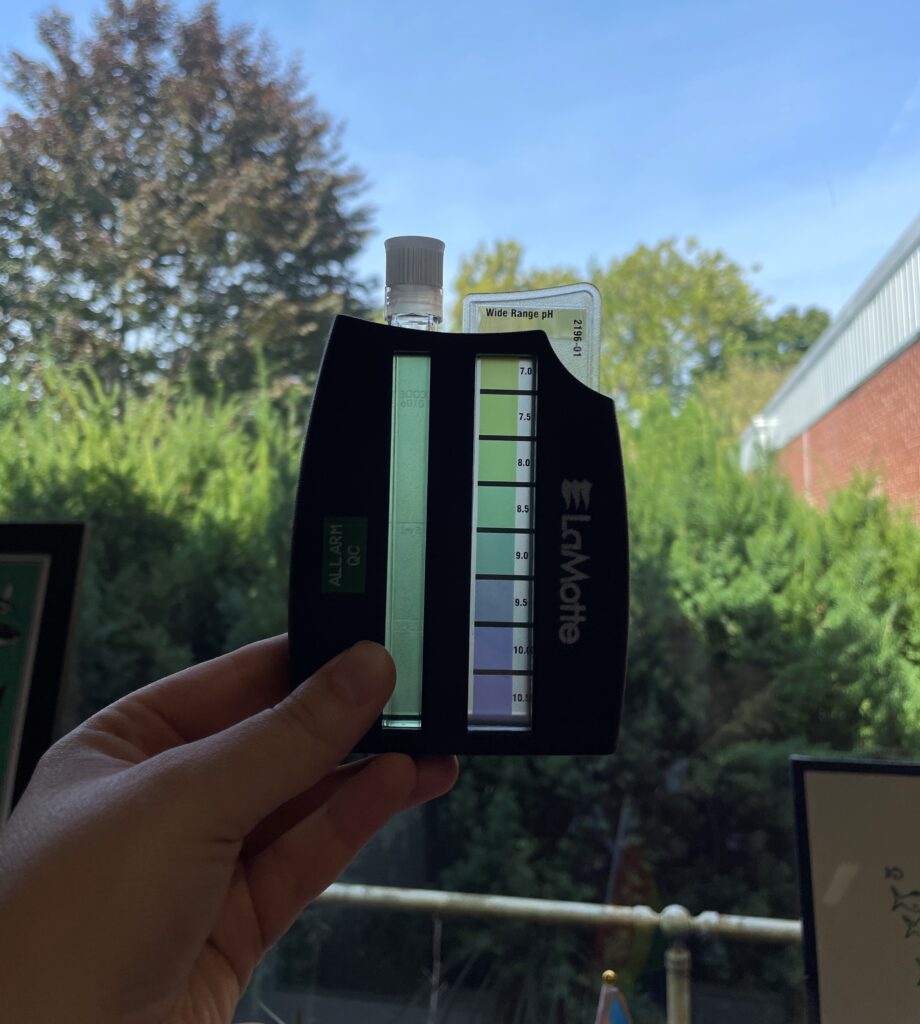ALLARM’s manuals and procedures are curated to make sure volunteers are consistently getting good quality results from their water quality testing. One of the trainer tips used by our volunteers, and highlighted in our Stream Team manual, which may often being overlooked is the angle at which a PH indicator dropper is meant to be held. It is instructed that volunteers (and us watershed coordinators in the lab!) use the droppers at a 90-degree angle, in other words held perfectly vertical when putting drops into the test tubes. During some trainings I have heard volunteers ask how much of a difference it makes if the dropper is not held at a perfect 90°, and I haven’t always been totally sure of the answer. Surely the angle you hold the dropper at can’t affect the outcome of the tests that much, right? I wouldn’t blame anyone for thinking this, as even the original instructions that came with the pH kit fail to mention what angle the dropper should be held at. One may think ALLARM added this extra requirement just to add an extra step, but this is not the case.
There are several scientific studies which have concluded that the angle at which the dropper is held has a large impact on the size of the drop. In several experiments it was found that with eye droppers, which are analogous to our pH droppers, using an angle of 90° was ideal (Šklubalová & Zatloukal, 2006, Brown et al., 2004). It was found that dispensing the drops at 90° from horizontal resulted in the largest drop sizes, and angles below 90° resulted in smaller drop sizes. Specifically, lowering the dispensing angle from vertical to 45° resulted in smaller drop sizes (Brown et al., 2004). Interestingly, in one study, below 90° the size of the drops decreased as expected until reaching 48°, at which point the drop sizes began to increase again (Šklubalová & Zatloukal, 2006). This increase was theorized to be due to a change in surface tension and wetting of the dropper tip (Šklubalová & Zatloukal, 2006). Previous studies have also found that air bubbles are more likely to affect the size of the drops at angles below 45° (Šklubalová & Zatloukal, 2005). All these factors result in drop sizes being significantly more variable below 45°. In fact, for some droppers used for medical purposes, it was found that they no longer met requirements of the European Pharmacopoeia because of how variable the size of drops became as the angle decreased from 90° (Brown et al., 2004).
Since we at ALLARM want all our tests to be accurate, and we want all collected data from our volunteers to be consistent, this increased variability is a problem. If the pH indicator dropper is held at an angle below 45° it would be nearly impossible for replicates to be consistent to one another due to the variability. A 90° angle experiences the least amount of variability which makes it perfect for our tests. Furthermore, it is important to have an easily recognizable angle to always use for our tests. If one month an 80° angle was used and the next month an 60° angle was used, this would impact the results of the test, even if just a little, which may incorrectly make it seem that something has changed in the stream. For this reason, it’s important to always use approximately the same angle every time a volunteer monitors their stream. Always holding the bottle vertical is an easy way to always be consistent.

__________
Works Cited
Brown, D., Ford, J. L., Nunn, A. J., & Rowe, P. H. (2004). An assessment of dose-uniformity of samples delivered from paediatric oral droppers. Journal of Clinical Pharmacy and Therapeutics, 29(6), 521–529. https://doi.org/10.1111/j.1365-2710.2004.00595.x
Šklubalová, Z., & Zatloukal, Z. (2006). Study of eye drops dispensing and dose variability by using plastic dropper tips. Drug Development and Industrial Pharmacy, 32(2), 197–205. https://doi.org/10.1080/03639040500466130
Sklubalová Z, Zatloukal Z. (2005). Systematic study of factors affecting eye drop size and dosing variability. Pharmazie, 60(12), 917-21.